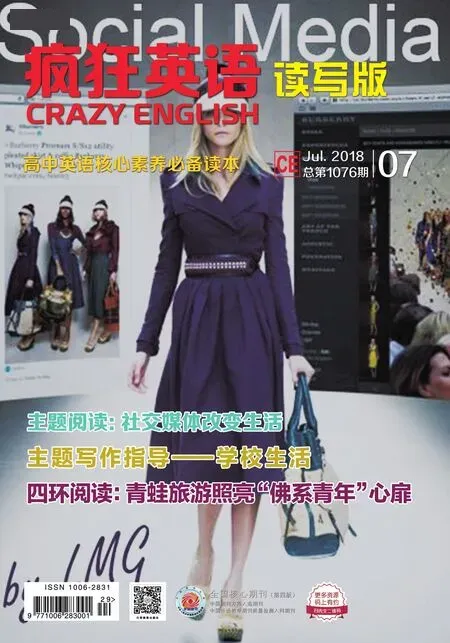大山深处的苗族
——没有银饰就不能结婚
2018-10-12陕西省渭南市富平县迤山中学任逾蓉
陕西省渭南市富平县迤山中学 任逾蓉
文章词数:361 建议用时:6′ 难度指数:★★★

精彩导读
银饰是苗族女孩结婚时的必备嫁妆,没有银饰就不能结婚。银饰象征着苗族的过去和文化。佩戴银饰不仅仅是一种对祖先的纪念,更是对苗族传统文化的遵守。同样,崇尚银饰成为苗族历代不衰的族群文化标识,这也是苗族服饰文化的根本标志。
When she①got married,Guanghui Wu was carrying 10kg of silver on her head and shoulders.
“Every girl has to get a set of silver to get married,”Wu explained.
For females from theMiaoethnic民族的group in the mountainous Guizhou Province of south-western China,wearing heavy and elaborate精心制作的silver headdresses and jewellery is common during weddings,funerals and the②annualSister’s Meal Festival.
Many families believe their daughters cannot get married if they don’t own a③propersilver outfit全套服装;装束,and start saving④up to10 years before the ceremony.
“You can tell a family’s wealth from the silver she is wearing,”Wu said.Her family has been making silver for at least three generations,and,even though her village and society is now rapidly changing,she is not ready to⑤give up the tradition.
“Without silver,a girl is not a girl,” an oldMiaosaying goes.
A disappearing art?
Only very young children and the elderly inhabit居住于the village.The tradition of silver-making⑥has deep roots inMiaoculture,but what will happen when the roots spread too far from the tree?
Hope for future generations.
Now 29,Wu works as a nurse in a hospital in Kaili.Although detached使分离from her village from a young age,Wu is proud of her heritage and of her family’s story:her parents got married with 1kg of silver on them,while she got to wear 10kg.She and her husband Shikun Yang plan to pass their people’s unique culture on to their children.
“Most kids are born and live in the cities.The parents no longer useMiaolanguage to communicate with their kids.Therefore,the language is slowly dying.I want my son to learn the language and keep our culture and tradition alive,”Wu said.
“Silver⑦stands fortheMiaoethnic group’s past and culture.Wearing silver is not only a memorial to the ancestors,but also the observance of the traditional culture of theMiaopeople.⑧Advocatingsilver ornaments饰品has become an enduring持久的cultural symbol of theMiaoethnic group and it is also the basic mark of theMiaopeople’s clothing culture.” an historian illustrated.
阅读扫障
Ⅰ.热词积累
①get married(to...) 与……结婚
②annual[謖覸nju藜l]adj.每年的
③proper[謖pr鬑p藜r]adj.恰当的;合适的
④up to达到
⑤give up the tradition放弃传统
⑥have deep roots in...在……根深蒂固⑦stand for代表;支持
⑧advocate[謖覸dv藜ke奘t]vt.提倡;主张
Ⅱ.难句分析
1.Although detached from her village from a young age,Wu is proud of her heritage and of her family’s story...尽管在很小的时候就离开了她的村庄,但吴光辉对她的传统和她的家庭故事感到自豪……
句中although引导的是让步状语从句;Although detached from相当于 Although she was detached from,因让步状语从句的逻辑主语与主句的主语同为Wu,故将让步状语从句中的主语和be动词was同时省略。
2.Wearing silver is not only a memorial to the ancestors,but also the observance of the traditional culture of the Miaopeople.佩戴银饰不仅仅是一种对祖先的纪念,更是对苗族传统文化的遵守。
本句使用的是“not only...,but also...”句型。 当 not only...,but also...连接并列的成分作主语时,谓语动词的单复数形式要遵循“就近原则”,即与最近的主语保持一致。
Not only I but also he likes English.不仅我而且他也喜欢英语。
Not only he but also I like English.不仅他而且我也喜欢英语。
译文助读
当吴光辉结婚的时候,她的头上和肩上披着10公斤重的银饰。
“每个女孩都必须拥有一套银饰才能结婚,”吴光辉解释道。
中国西南部多山的贵州省的苗族妇女,在婚礼、葬礼和一年一度的姐妹节期间,佩戴沉重而精致的银色头饰和珠宝是很常见的。
许多家庭认为,如果他们的女儿没有全套合适的银饰装就不能结婚,并且他们会在女儿结婚前10年就开始准备。
吴光辉说:“你可以从她佩戴的银饰看出这个家庭是否富有。”她的家庭至少有三代人在制造银饰,尽管她的村庄和社会正在迅速变化着,但她也没有打算放弃传统。
“没有银饰的女孩不算女孩,”一个古老的苗族谚语这样说。
一种消失的艺术?
只有很小的孩子和老人住在村子里。在苗族文化中,制银的传统根深蒂固,但当传统越来越远,会发生什么呢?
寄希望于后代。
现年29岁的吴光辉在凯里市的一家医院当护士。尽管她在很小的时候就离开了村庄,但吴光辉对她的传统和她的家庭故事感到自豪:她的父母结婚时佩戴着1公斤的银饰,而她佩戴了10公斤。她和她的丈夫杨世坤计划将他们的民族独特的文化传给他们的孩子。
吴光辉说:“大多数孩子出生并居住在城市。父母不再用苗语与孩子交流。因此,这种语言正在慢慢消亡。我希望我儿子去学习这种语言,让我们的文化和传统流传下去。”
一位历史学家解释道:“银饰象征着苗族的过去和文化。佩戴银饰不仅仅是一种对祖先的纪念,更是对苗族传统文化的遵守。同样,崇尚银饰成为苗族历代不衰的族群文化标识,这也是苗族服饰文化的根本标志。”

